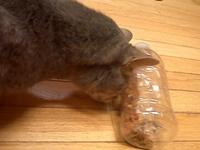Feline foraging toys - easy, fun and effective!

Silver, enthusiastically playing with his enrichment toy. Created by reaming holes into a clean, recycled plastic bottle and filled with a ration of dry cat food and treats.
Caring for felines is a huge part of my business, and frequently my clients ask about how to address behavioral issues that they encounter with their cats. It can be a bit challenging at times to co-exist with them, but really understanding your pets' breed is a great starting place. There is no 'one size fits all' personality for felines.
All feline breeds differ in behavioral characteristics, like Maine Coons, who are quite engaging - and known to love playing fetch with their owners, as do Manx. Others, like Devon Rex are excellent jumpers, highly active and really just love to be physically close and involved with their people. Siamese cats are extremely vocal. Havana Browns do not thrive in environments where they'll be left alone much of the time. Some breeds are excellent mousers.
What's important to remember is that all cats, including the Domestic Shorthair have their own specific needs and motives behind their behavior. A key part of that, is keeping in mind that cats need stimulation to satisfy their minds, and their prey drive. You won't find too many folks talking about that. By contrast, the prey drive of a dog is a topic of higher precedence in my experience. Is it because dogs are larger, more likely to inflict damage or to kill because of their size... or that they spend more time out with us in a social setting? Perhaps.
However, in my time with felines, I've seen firsthand that they have retained more of their prey drive and natural instincts - and yet they spend more time inside than a dog does, on average. Additionally, cats are crepuscular (most active at dusk and dawn) - not nocturnal, as most believe. With the lack of hunting time outside, their prey drive and being on a different time clock than the rest of us, it's no wonder that some cats behave in ways that we don't understand. Destructive and negative behavior can extend to the point of having Obsessive Compulsive Disorder and Psychogenic Alopecia (both typically manifested by over grooming).
Are there things that we can do to help cats live to their full potential? Yes! Stimulating experiences are important. An environment that is engaging - fun cat toys, cubbys to play in, interaction from their people - and foraging toys. You see, cats are wired to hunt for their food - their prey drive. They like to do it. Most toys have only half of the equation right for keeping felines happy as far as the need to hunt - but there is nothing to show for their work. They need to get the food in the end.
I have a fun and easy solution: Foraging toys. (Ever see a dog with a Kong? Same principle.) These unique tools help cats to utilize their instinctive skills. Foraging toys are easy enough to make at home, for free... and you can recycle at the same time! I made a new one today out of a recycled sports drink bottle and filled it with a ration of cat food, treats and maybe a little catnip to spark interest. Just set it on the floor, get their attention and there you go. Simple enough, right?
You can use empty, clean water bottles, and even plastic pop bottles with secure lids are good choices - having a variety of toys to rotate each week is helpful. Simply ream out holes big enough for food and treats to trickle out as your kitty bats the toy around. Initially, choose clear vessels so that they can see the goodies inside and have a chance to get accustomed to how it works.
A secondary benefit to this: cats have less of a tendency to overeat or to eat out of boredom - possibly addressing weight problems.
Following her bliss, Lorrie Shaw is owner of Professional Pet Sitting and lives in Dexter Township with her family that includes a small brood of pets. As a contributor in the pets section for AnnArbor.com, she's always striving to provide interesting, fresh information on pet related topics. A ravenous foodie, in her free moments she can be found huddled in her kitchen standing over a hot stove and listening to any good music. She welcomes your e-mail contact.


Comments
xfdragon
Thu, Mar 24, 2011 : 2:45 p.m.
Thanks for the info...just ordered 2 of them...
Catwoman57
Sun, Aug 1, 2010 : 6:52 a.m.
A really cool cat foraging toy can be found at www.batarat.com!